Preparation and Analysis of AWM Manufacturing Budget for 2019
VerifiedAdded on 2022/12/09
|7
|1544
|236
Project
AI Summary
This project presents a comprehensive budget analysis for AWM Manufacturing Ltd. for the year 2019. It starts with the preparation of a base-case budget using provided accounting information and then proceeds with the analysis of this budget across various financial metrics, including net sales, collections, inventory levels, debt costs, and net profit. The project further explores multiple scenarios through simulations, considering factors like price increases, credit tightening, and inventory adjustments. These alternative scenarios are then compared against the base case to identify an optimal budget plan that maximizes the company's long-term wealth. Additionally, the analysis includes suggestions for improving budget efficiency, such as break-even analysis and working capital management, along with a brief introduction to the Balanced Scorecard as an informational reference for the management's consideration. The project concludes with recommendations regarding dividend payments, emphasizing the importance of a balanced approach to maintain shareholder trust while ensuring the company's financial stability.
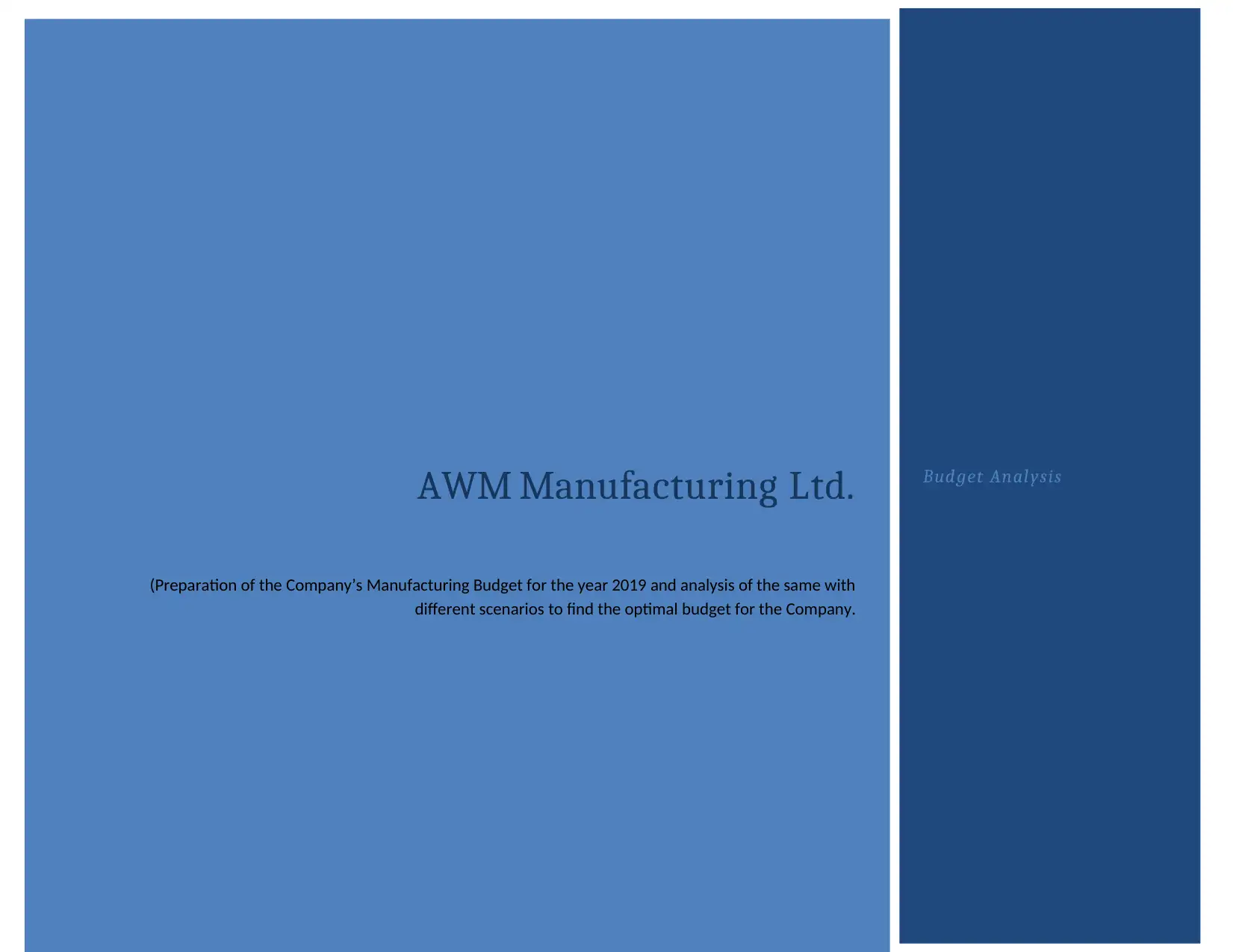
AWM Manufacturing Ltd.
(Preparation of the Company’s Manufacturing Budget for the year 2019 and analysis of the same with
different scenarios to find the optimal budget for the Company.
Budget Analysis
(Preparation of the Company’s Manufacturing Budget for the year 2019 and analysis of the same with
different scenarios to find the optimal budget for the Company.
Budget Analysis
Paraphrase This Document
Need a fresh take? Get an instant paraphrase of this document with our AI Paraphraser
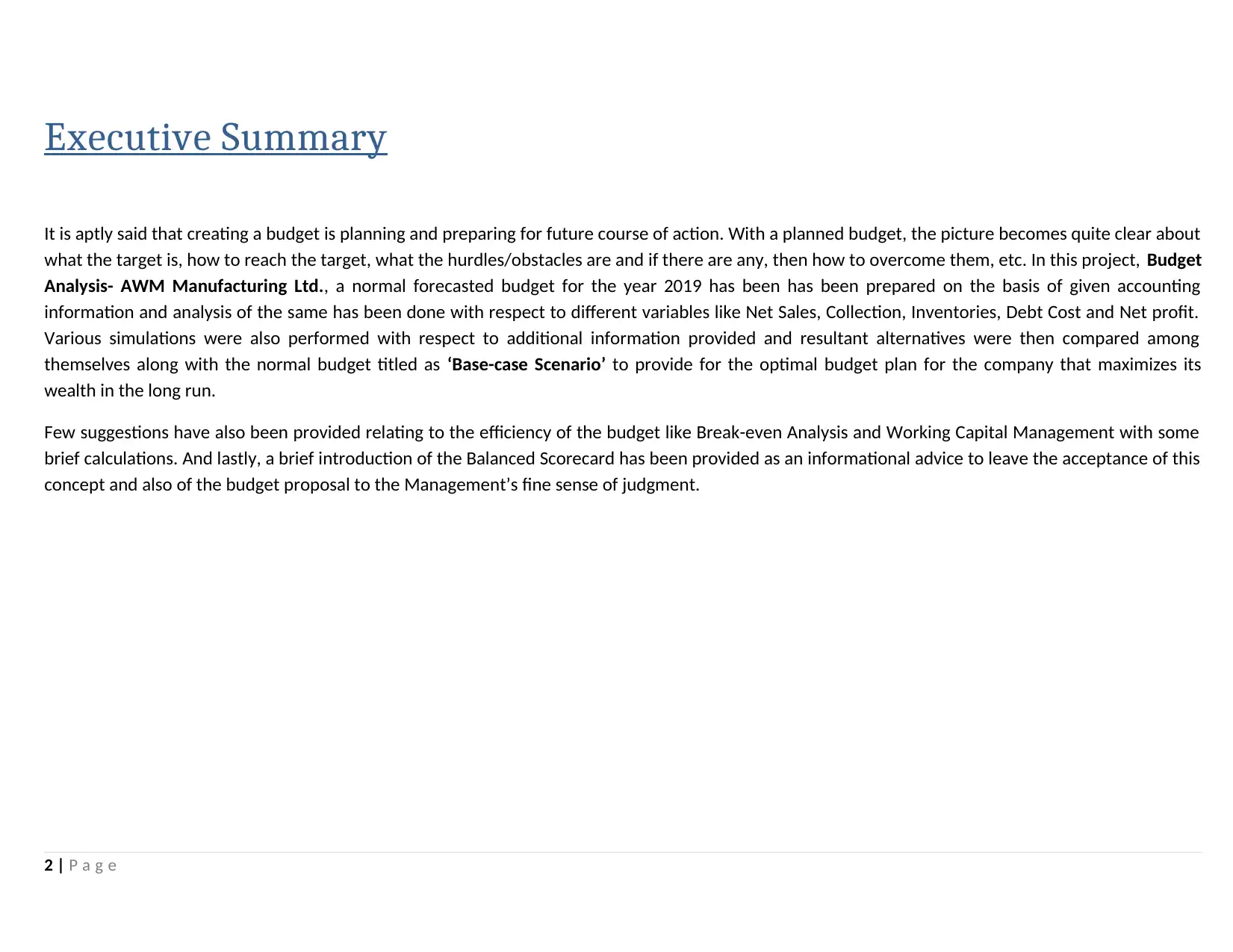
Executive Summary
It is aptly said that creating a budget is planning and preparing for future course of action. With a planned budget, the picture becomes quite clear about
what the target is, how to reach the target, what the hurdles/obstacles are and if there are any, then how to overcome them, etc. In this project, Budget
Analysis- AWM Manufacturing Ltd., a normal forecasted budget for the year 2019 has been has been prepared on the basis of given accounting
information and analysis of the same has been done with respect to different variables like Net Sales, Collection, Inventories, Debt Cost and Net profit.
Various simulations were also performed with respect to additional information provided and resultant alternatives were then compared among
themselves along with the normal budget titled as ‘Base-case Scenario’ to provide for the optimal budget plan for the company that maximizes its
wealth in the long run.
Few suggestions have also been provided relating to the efficiency of the budget like Break-even Analysis and Working Capital Management with some
brief calculations. And lastly, a brief introduction of the Balanced Scorecard has been provided as an informational advice to leave the acceptance of this
concept and also of the budget proposal to the Management’s fine sense of judgment.
2 | P a g e
It is aptly said that creating a budget is planning and preparing for future course of action. With a planned budget, the picture becomes quite clear about
what the target is, how to reach the target, what the hurdles/obstacles are and if there are any, then how to overcome them, etc. In this project, Budget
Analysis- AWM Manufacturing Ltd., a normal forecasted budget for the year 2019 has been has been prepared on the basis of given accounting
information and analysis of the same has been done with respect to different variables like Net Sales, Collection, Inventories, Debt Cost and Net profit.
Various simulations were also performed with respect to additional information provided and resultant alternatives were then compared among
themselves along with the normal budget titled as ‘Base-case Scenario’ to provide for the optimal budget plan for the company that maximizes its
wealth in the long run.
Few suggestions have also been provided relating to the efficiency of the budget like Break-even Analysis and Working Capital Management with some
brief calculations. And lastly, a brief introduction of the Balanced Scorecard has been provided as an informational advice to leave the acceptance of this
concept and also of the budget proposal to the Management’s fine sense of judgment.
2 | P a g e
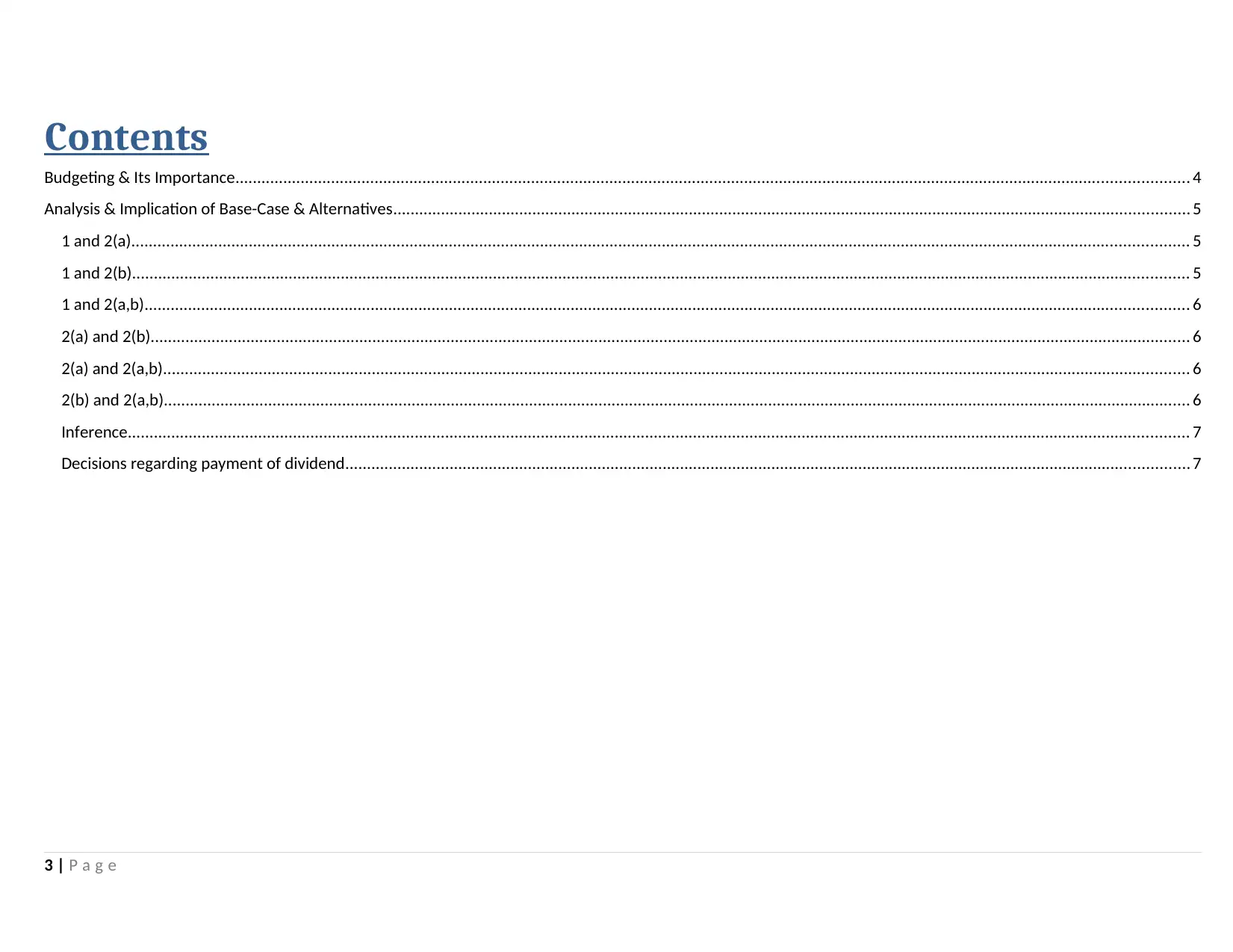
Contents
Budgeting & Its Importance........................................................................................................................................................................................................................... 4
Analysis & Implication of Base-Case & Alternatives....................................................................................................................................................................................... 5
1 and 2(a)................................................................................................................................................................................................................................................... 5
1 and 2(b)................................................................................................................................................................................................................................................... 5
1 and 2(a,b)................................................................................................................................................................................................................................................ 6
2(a) and 2(b)............................................................................................................................................................................................................................................... 6
2(a) and 2(a,b)............................................................................................................................................................................................................................................ 6
2(b) and 2(a,b)............................................................................................................................................................................................................................................ 6
Inference.................................................................................................................................................................................................................................................... 7
Decisions regarding payment of dividend.................................................................................................................................................................................................. 7
3 | P a g e
Budgeting & Its Importance........................................................................................................................................................................................................................... 4
Analysis & Implication of Base-Case & Alternatives....................................................................................................................................................................................... 5
1 and 2(a)................................................................................................................................................................................................................................................... 5
1 and 2(b)................................................................................................................................................................................................................................................... 5
1 and 2(a,b)................................................................................................................................................................................................................................................ 6
2(a) and 2(b)............................................................................................................................................................................................................................................... 6
2(a) and 2(a,b)............................................................................................................................................................................................................................................ 6
2(b) and 2(a,b)............................................................................................................................................................................................................................................ 6
Inference.................................................................................................................................................................................................................................................... 7
Decisions regarding payment of dividend.................................................................................................................................................................................................. 7
3 | P a g e
⊘ This is a preview!⊘
Do you want full access?
Subscribe today to unlock all pages.

Trusted by 1+ million students worldwide
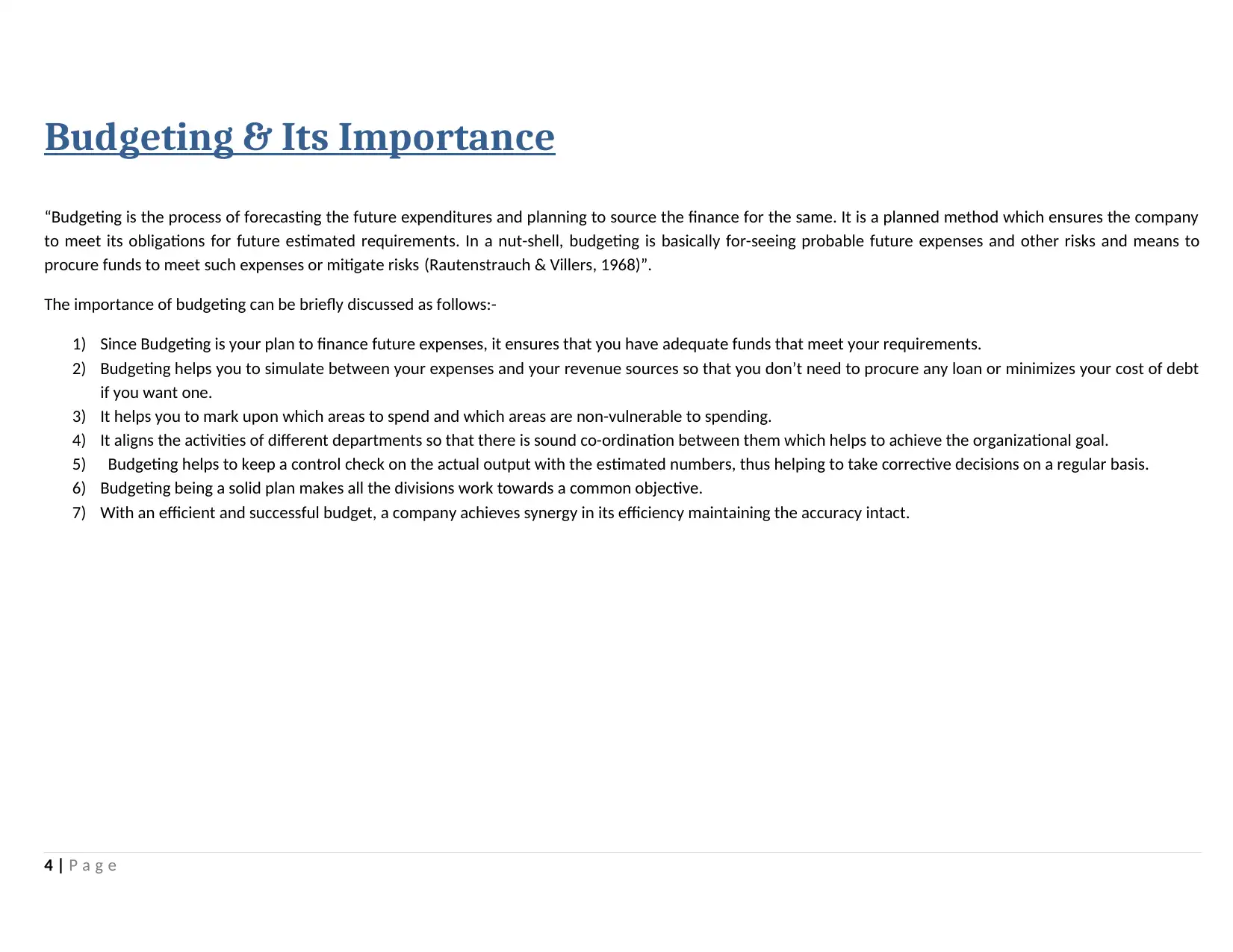
Budgeting & Its Importance
“Budgeting is the process of forecasting the future expenditures and planning to source the finance for the same. It is a planned method which ensures the company
to meet its obligations for future estimated requirements. In a nut-shell, budgeting is basically for-seeing probable future expenses and other risks and means to
procure funds to meet such expenses or mitigate risks (Rautenstrauch & Villers, 1968)”.
The importance of budgeting can be briefly discussed as follows:-
1) Since Budgeting is your plan to finance future expenses, it ensures that you have adequate funds that meet your requirements.
2) Budgeting helps you to simulate between your expenses and your revenue sources so that you don’t need to procure any loan or minimizes your cost of debt
if you want one.
3) It helps you to mark upon which areas to spend and which areas are non-vulnerable to spending.
4) It aligns the activities of different departments so that there is sound co-ordination between them which helps to achieve the organizational goal.
5) Budgeting helps to keep a control check on the actual output with the estimated numbers, thus helping to take corrective decisions on a regular basis.
6) Budgeting being a solid plan makes all the divisions work towards a common objective.
7) With an efficient and successful budget, a company achieves synergy in its efficiency maintaining the accuracy intact.
4 | P a g e
“Budgeting is the process of forecasting the future expenditures and planning to source the finance for the same. It is a planned method which ensures the company
to meet its obligations for future estimated requirements. In a nut-shell, budgeting is basically for-seeing probable future expenses and other risks and means to
procure funds to meet such expenses or mitigate risks (Rautenstrauch & Villers, 1968)”.
The importance of budgeting can be briefly discussed as follows:-
1) Since Budgeting is your plan to finance future expenses, it ensures that you have adequate funds that meet your requirements.
2) Budgeting helps you to simulate between your expenses and your revenue sources so that you don’t need to procure any loan or minimizes your cost of debt
if you want one.
3) It helps you to mark upon which areas to spend and which areas are non-vulnerable to spending.
4) It aligns the activities of different departments so that there is sound co-ordination between them which helps to achieve the organizational goal.
5) Budgeting helps to keep a control check on the actual output with the estimated numbers, thus helping to take corrective decisions on a regular basis.
6) Budgeting being a solid plan makes all the divisions work towards a common objective.
7) With an efficient and successful budget, a company achieves synergy in its efficiency maintaining the accuracy intact.
4 | P a g e
Paraphrase This Document
Need a fresh take? Get an instant paraphrase of this document with our AI Paraphraser
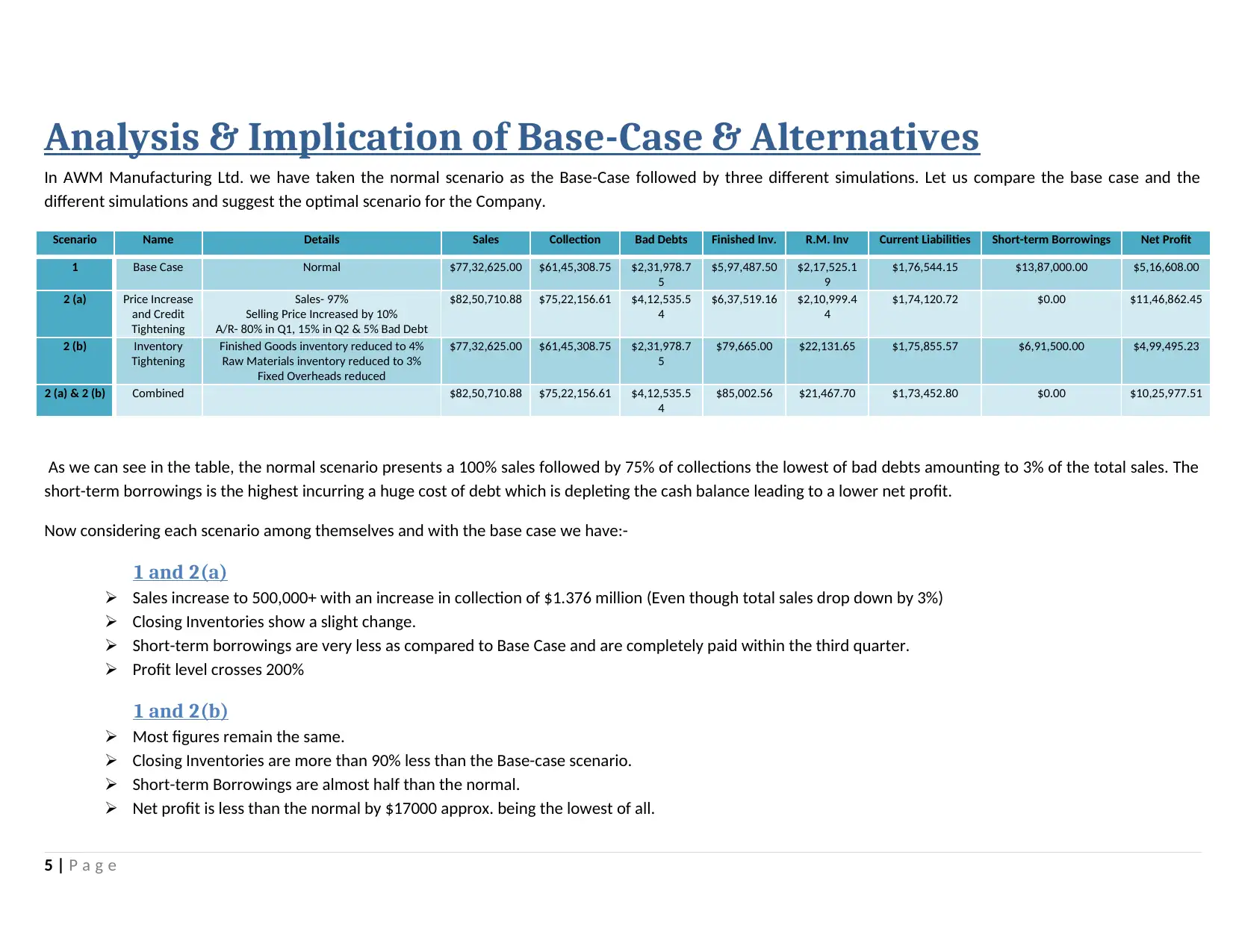
Analysis & Implication of Base-Case & Alternatives
In AWM Manufacturing Ltd. we have taken the normal scenario as the Base-Case followed by three different simulations. Let us compare the base case and the
different simulations and suggest the optimal scenario for the Company.
Scenario Name Details Sales Collection Bad Debts Finished Inv. R.M. Inv Current Liabilities Short-term Borrowings Net Profit
1 Base Case Normal $77,32,625.00 $61,45,308.75 $2,31,978.7
5
$5,97,487.50 $2,17,525.1
9
$1,76,544.15 $13,87,000.00 $5,16,608.00
2 (a) Price Increase
and Credit
Tightening
Sales- 97%
Selling Price Increased by 10%
A/R- 80% in Q1, 15% in Q2 & 5% Bad Debt
$82,50,710.88 $75,22,156.61 $4,12,535.5
4
$6,37,519.16 $2,10,999.4
4
$1,74,120.72 $0.00 $11,46,862.45
2 (b) Inventory
Tightening
Finished Goods inventory reduced to 4%
Raw Materials inventory reduced to 3%
Fixed Overheads reduced
$77,32,625.00 $61,45,308.75 $2,31,978.7
5
$79,665.00 $22,131.65 $1,75,855.57 $6,91,500.00 $4,99,495.23
2 (a) & 2 (b) Combined $82,50,710.88 $75,22,156.61 $4,12,535.5
4
$85,002.56 $21,467.70 $1,73,452.80 $0.00 $10,25,977.51
As we can see in the table, the normal scenario presents a 100% sales followed by 75% of collections the lowest of bad debts amounting to 3% of the total sales. The
short-term borrowings is the highest incurring a huge cost of debt which is depleting the cash balance leading to a lower net profit.
Now considering each scenario among themselves and with the base case we have:-
1 and 2(a)
Sales increase to 500,000+ with an increase in collection of $1.376 million (Even though total sales drop down by 3%)
Closing Inventories show a slight change.
Short-term borrowings are very less as compared to Base Case and are completely paid within the third quarter.
Profit level crosses 200%
1 and 2(b)
Most figures remain the same.
Closing Inventories are more than 90% less than the Base-case scenario.
Short-term Borrowings are almost half than the normal.
Net profit is less than the normal by $17000 approx. being the lowest of all.
5 | P a g e
In AWM Manufacturing Ltd. we have taken the normal scenario as the Base-Case followed by three different simulations. Let us compare the base case and the
different simulations and suggest the optimal scenario for the Company.
Scenario Name Details Sales Collection Bad Debts Finished Inv. R.M. Inv Current Liabilities Short-term Borrowings Net Profit
1 Base Case Normal $77,32,625.00 $61,45,308.75 $2,31,978.7
5
$5,97,487.50 $2,17,525.1
9
$1,76,544.15 $13,87,000.00 $5,16,608.00
2 (a) Price Increase
and Credit
Tightening
Sales- 97%
Selling Price Increased by 10%
A/R- 80% in Q1, 15% in Q2 & 5% Bad Debt
$82,50,710.88 $75,22,156.61 $4,12,535.5
4
$6,37,519.16 $2,10,999.4
4
$1,74,120.72 $0.00 $11,46,862.45
2 (b) Inventory
Tightening
Finished Goods inventory reduced to 4%
Raw Materials inventory reduced to 3%
Fixed Overheads reduced
$77,32,625.00 $61,45,308.75 $2,31,978.7
5
$79,665.00 $22,131.65 $1,75,855.57 $6,91,500.00 $4,99,495.23
2 (a) & 2 (b) Combined $82,50,710.88 $75,22,156.61 $4,12,535.5
4
$85,002.56 $21,467.70 $1,73,452.80 $0.00 $10,25,977.51
As we can see in the table, the normal scenario presents a 100% sales followed by 75% of collections the lowest of bad debts amounting to 3% of the total sales. The
short-term borrowings is the highest incurring a huge cost of debt which is depleting the cash balance leading to a lower net profit.
Now considering each scenario among themselves and with the base case we have:-
1 and 2(a)
Sales increase to 500,000+ with an increase in collection of $1.376 million (Even though total sales drop down by 3%)
Closing Inventories show a slight change.
Short-term borrowings are very less as compared to Base Case and are completely paid within the third quarter.
Profit level crosses 200%
1 and 2(b)
Most figures remain the same.
Closing Inventories are more than 90% less than the Base-case scenario.
Short-term Borrowings are almost half than the normal.
Net profit is less than the normal by $17000 approx. being the lowest of all.
5 | P a g e
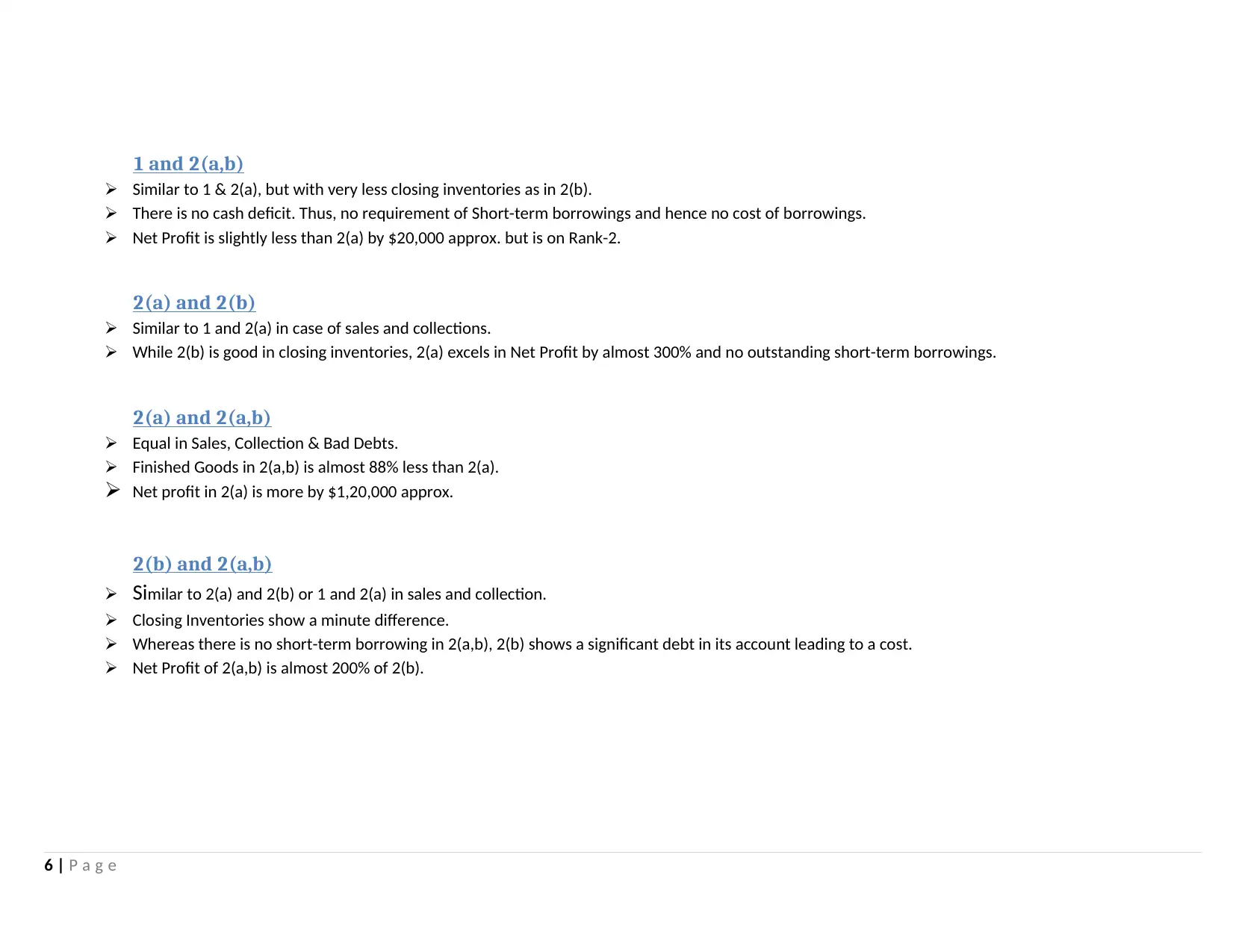
1 and 2(a,b)
Similar to 1 & 2(a), but with very less closing inventories as in 2(b).
There is no cash deficit. Thus, no requirement of Short-term borrowings and hence no cost of borrowings.
Net Profit is slightly less than 2(a) by $20,000 approx. but is on Rank-2.
2(a) and 2(b)
Similar to 1 and 2(a) in case of sales and collections.
While 2(b) is good in closing inventories, 2(a) excels in Net Profit by almost 300% and no outstanding short-term borrowings.
2(a) and 2(a,b)
Equal in Sales, Collection & Bad Debts.
Finished Goods in 2(a,b) is almost 88% less than 2(a).
Net profit in 2(a) is more by $1,20,000 approx.
2(b) and 2(a,b)
Similar to 2(a) and 2(b) or 1 and 2(a) in sales and collection.
Closing Inventories show a minute difference.
Whereas there is no short-term borrowing in 2(a,b), 2(b) shows a significant debt in its account leading to a cost.
Net Profit of 2(a,b) is almost 200% of 2(b).
6 | P a g e
Similar to 1 & 2(a), but with very less closing inventories as in 2(b).
There is no cash deficit. Thus, no requirement of Short-term borrowings and hence no cost of borrowings.
Net Profit is slightly less than 2(a) by $20,000 approx. but is on Rank-2.
2(a) and 2(b)
Similar to 1 and 2(a) in case of sales and collections.
While 2(b) is good in closing inventories, 2(a) excels in Net Profit by almost 300% and no outstanding short-term borrowings.
2(a) and 2(a,b)
Equal in Sales, Collection & Bad Debts.
Finished Goods in 2(a,b) is almost 88% less than 2(a).
Net profit in 2(a) is more by $1,20,000 approx.
2(b) and 2(a,b)
Similar to 2(a) and 2(b) or 1 and 2(a) in sales and collection.
Closing Inventories show a minute difference.
Whereas there is no short-term borrowing in 2(a,b), 2(b) shows a significant debt in its account leading to a cost.
Net Profit of 2(a,b) is almost 200% of 2(b).
6 | P a g e
⊘ This is a preview!⊘
Do you want full access?
Subscribe today to unlock all pages.

Trusted by 1+ million students worldwide
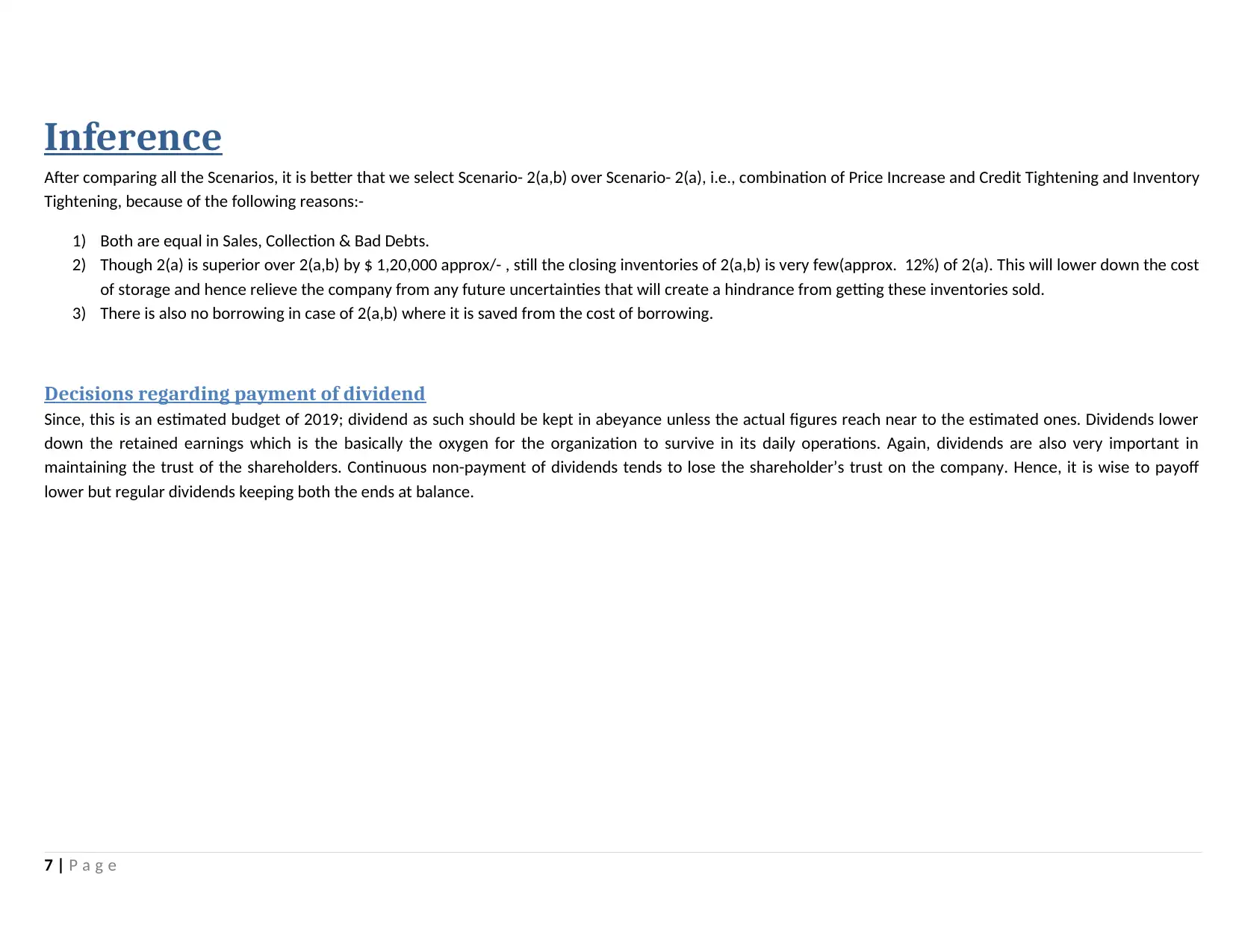
Inference
After comparing all the Scenarios, it is better that we select Scenario- 2(a,b) over Scenario- 2(a), i.e., combination of Price Increase and Credit Tightening and Inventory
Tightening, because of the following reasons:-
1) Both are equal in Sales, Collection & Bad Debts.
2) Though 2(a) is superior over 2(a,b) by $ 1,20,000 approx/- , still the closing inventories of 2(a,b) is very few(approx. 12%) of 2(a). This will lower down the cost
of storage and hence relieve the company from any future uncertainties that will create a hindrance from getting these inventories sold.
3) There is also no borrowing in case of 2(a,b) where it is saved from the cost of borrowing.
Decisions regarding payment of dividend
Since, this is an estimated budget of 2019; dividend as such should be kept in abeyance unless the actual figures reach near to the estimated ones. Dividends lower
down the retained earnings which is the basically the oxygen for the organization to survive in its daily operations. Again, dividends are also very important in
maintaining the trust of the shareholders. Continuous non-payment of dividends tends to lose the shareholder’s trust on the company. Hence, it is wise to payoff
lower but regular dividends keeping both the ends at balance.
7 | P a g e
After comparing all the Scenarios, it is better that we select Scenario- 2(a,b) over Scenario- 2(a), i.e., combination of Price Increase and Credit Tightening and Inventory
Tightening, because of the following reasons:-
1) Both are equal in Sales, Collection & Bad Debts.
2) Though 2(a) is superior over 2(a,b) by $ 1,20,000 approx/- , still the closing inventories of 2(a,b) is very few(approx. 12%) of 2(a). This will lower down the cost
of storage and hence relieve the company from any future uncertainties that will create a hindrance from getting these inventories sold.
3) There is also no borrowing in case of 2(a,b) where it is saved from the cost of borrowing.
Decisions regarding payment of dividend
Since, this is an estimated budget of 2019; dividend as such should be kept in abeyance unless the actual figures reach near to the estimated ones. Dividends lower
down the retained earnings which is the basically the oxygen for the organization to survive in its daily operations. Again, dividends are also very important in
maintaining the trust of the shareholders. Continuous non-payment of dividends tends to lose the shareholder’s trust on the company. Hence, it is wise to payoff
lower but regular dividends keeping both the ends at balance.
7 | P a g e
1 out of 7
Related Documents
Your All-in-One AI-Powered Toolkit for Academic Success.
+13062052269
info@desklib.com
Available 24*7 on WhatsApp / Email
![[object Object]](/_next/static/media/star-bottom.7253800d.svg)
Unlock your academic potential
Copyright © 2020–2025 A2Z Services. All Rights Reserved. Developed and managed by ZUCOL.




